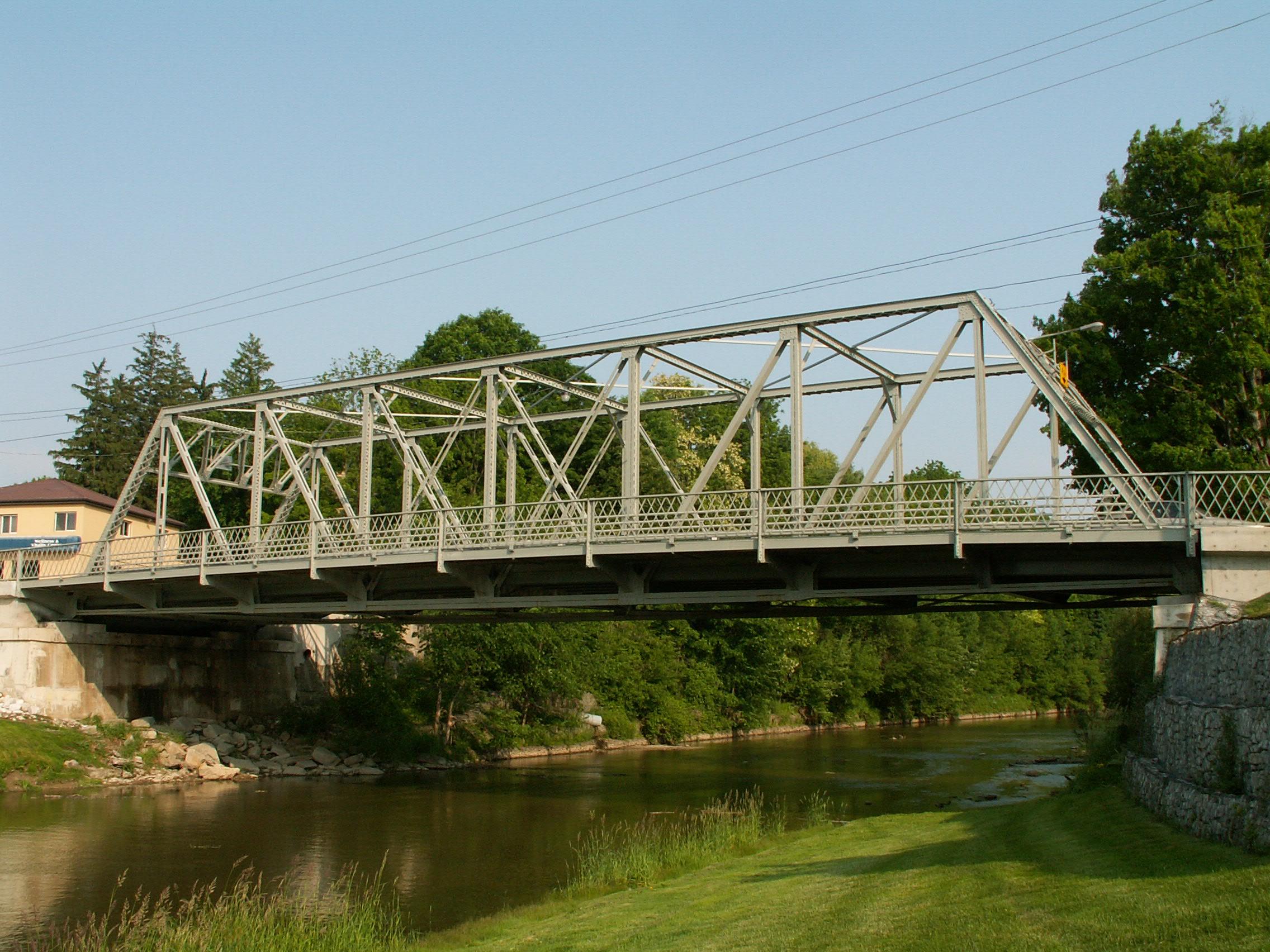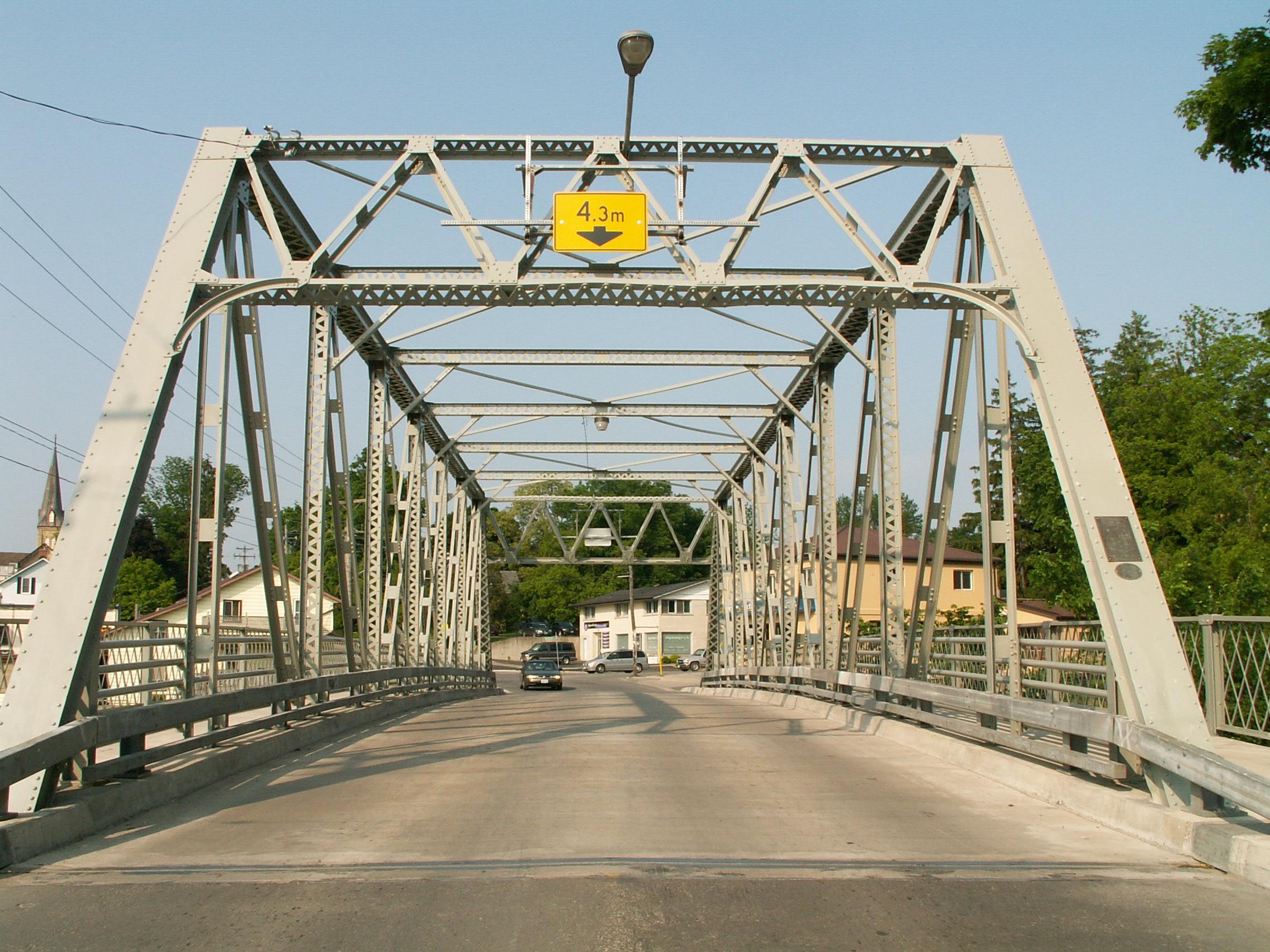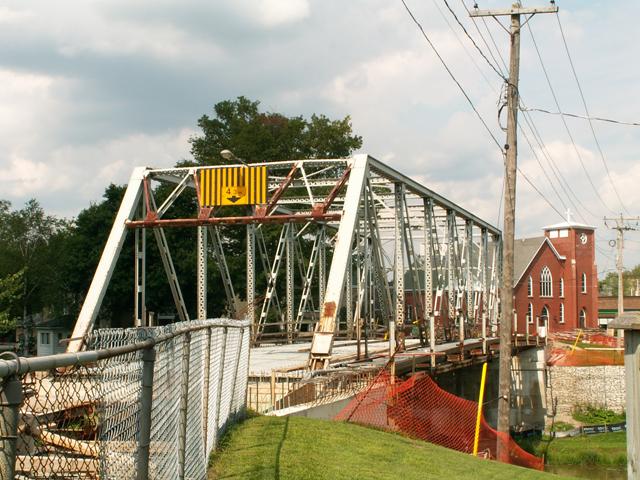We Recommend:
Bach Steel - Experts at historic truss bridge restoration.
Hartman Bridge
New Hamburg Bridge

Primary Photographer(s): Nathan Holth
Bridge Documented: June 8, 2007
Wilmot Township (New Hamburg): Waterloo Region, Ontario: Canada
1936 By Builder/Contractor: Hamilton Bridge Company of Hamilton, Ontario
2006
136.2 Feet (41.5 Meters)
136.2 Feet (41.5 Meters)
37.4 Feet (11.4 Meters)
1 Main Span(s)
Not Applicable

View Information About HSR Ratings
Bridge Documentation

This
bridge is an eight panel Pratt through truss with riveted connections. It
forms an attractive centerpiece for the small town of New Hamburg, uniting
the east and west sides of town. Waterloo Region opted to restore this
designated heritage structure, representing an important move forward for
the community of New Hamburg and Ontario in general. As a result, New
Hamburg can continue to enjoy the beauty this bridge adds to the town, and
future generations will be able to admire the complex design that is behind
any historic metal truss bridge.
This truss bridge features an unusual deck that is slightly arched. The
bridge features a v-laced design for a portal brace. V-lacing is also
present within the steel of the portal bracing, as well as on the sway
bracing and the verticals. There is lattice under the top chord and end
posts. The western portal bracing was damaged in the past, and portions of
it were replaced. This work was done prior to the restoration work being
done in 2006. The bridge sits on concrete abutments. The bridge was built in
the 1930s. In Ontario, concrete bridges were becoming the more common
structure type to build at this time, but because of the Depression, it was
found that the metal truss bridge was more economical to build. The bridge
is thus significant as a bridge built during the Depression, and whose
design was influenced by the troubled times of this important period in
history.

The bridge retains a great deal of historic integrity, with only the partially replaced portal bracing at the west end of the bridge the most noticeable alteration. The bridge retains original lattice railings on the cantilevered sidewalks. It also retains builder plaques, including a county plaque, as well as the Hamilton Bridge Company's trademark oval-shaped plaques. Very few truss bridges in Ontario appear to retain plaques, so this is a significant feature of the Hartman Bridge. The Hamilton Bridge Company is an important company, as it was a prolific company. It also is noteworthy for the area as it was a local company and thus is part of the southern Ontario's history. The integrity of the steel is good also. Most rivets remain in place, and are not replaced with bolts. No visible evidence of repairs where plate steel was welded onto the bridge were readily visible either. These are all indications of a structure that has not been significantly altered.

The restoration of this bridge in 2006 represents an excellent job that sets an example for future preservation projects due to the attention paid to historic integrity. The attention given to retaining historic integrity, even with the small details, is a key part of any preservation project, yet is unfortunately often ignored in other preservation projects, resulting in a bridge that might look about the same from a distance, but up close does not look genuine. The Hartman Bridge's restoration is a pleasing departure from that trend. Among the important details that were retained are the lattice railings on the pedestrian sidewalks. Railings are often an aspect that is ignored in bridge restoration, perhaps more than any other element. Despite this, railings are a very visible part of the bridge, and thus their retention plays a major role in keeping the bridge looking beautiful, original, and historic. As far as guardrails to protect both vehicles and bridge trusses, the choice was excellent as well. Rather than erect unsightly concrete barriers, or steel Armco guardrails, very low profile metal guardrails were used. Because they are both low, and also are not a solid wall, they do not impede the view of the bridge, but they are still sturdy enough to ensure that vehicles will not crash into the trusses of the bridge and damage it. Finally, the other element that was important was that not only were the floor beams not replaced, nearly all of the deck stringers were not replaced. Only the last set of deck stringers at each end were replaced. The rest are original. Deck stringers are usually the first thing to go on a restoration, and floor beams are often not far behind. Keeping the original flooring system for a truss bridge is important. Although casual viewers may not take notice, heading under a bridge is often the first thing bridge enthusiasts will do. With the Hartman Bridge, such people will see the original floor beams and deck stringers. The floor beams are built-up and thus feature a riveted construction. The deck stringers are rolled i-beams, and they are riveted onto the floor beams. The deck was redone on the bridge also. The deck uses several innovative features that decrease dead weight on the bridge, allowing the bridge to now not have a posted weight limit. The deck however is surfaced with concrete, which not only provides a smooth riding surface, but provides a traditional period appearance as well.

The lattice railings are both beautiful and also tell a story about the bridge. The lattice in the railings feature both steel bars and steel angles. This angle-bar combination is found on numerous historic truss and stringer bridges in Ontario. Interestingly, in the United States however, lattice railing were hardly ever built like this, using only bars. The reason for the use of the angle-bar combination is unknown. Perhaps a local fabricator, perhaps in Hamilton, was responsible for the unusual design. The angle-bar design does appear to be a smart one, as it would likely give more strength to the railings than the all-bar design. In either case the angle-bar railing design is something that defines the Ontario truss bridge.
Information and Findings From Waterloo Region Heritage Bridge InventoryWaterloo Region Assigned Heritage Ratings: Overall Score: 70. (Heritage Bridge scores range from 50 up to generally 78) Listed in Top Ten Waterloo Region Heritage Bridge List. Rank: #4 View Heritage Bridge Inventory Data SheetsInformative Heritage Bridge Plaque Placed Near Bridge:
 Click above thumbnails to view readable full-size versions. |
![]()
Photo Galleries and Videos: Hartman Bridge
Original / Full Size Gallery
Original / Full Size PhotosFor the best visual immersion and full detail, or for use as a desktop background, this gallery presents selected overview and detail photos for this bridge in the original digital camera resolution. This gallery offers photos in the highest available resolution and file size in a touch-friendly popup viewer.
Alternatively, Browse Without Using Viewer
![]()
Structure Overview
Mobile Optimized PhotosA collection of overview photos that show the bridge as a whole and general areas of the bridge. This gallery features data-friendly, fast-loading photos in a touch-friendly popup viewer.
Alternatively, Browse Without Using Viewer
![]()
Structure Details
Mobile Optimized PhotosA collection of detail photos that document the parts, construction, and condition of the bridge. This gallery features data-friendly, fast-loading photos in a touch-friendly popup viewer.
Alternatively, Browse Without Using Viewer
![]()
Rehabilitation Gallery
A collection of photos from while the rehabilitation project was ongoing. This photo gallery contains a combination of Original Size photos and Mobile Optimized photos in a touch-friendly popup viewer.Alternatively, Browse Without Using Viewer
![]()
Heritage Plaque Unveiling
A collection of photos of this special event for the bridge's interpretive plaque. This photo gallery contains a combination of Original Size photos and Mobile Optimized photos in a touch-friendly popup viewer.Alternatively, Browse Without Using Viewer
![]()
Maps and Links: Hartman Bridge
Coordinates (Latitude, Longitude):
Search For Additional Bridge Listings:
Additional Maps:
Google Streetview (If Available)
GeoHack (Additional Links and Coordinates)
Apple Maps (Via DuckDuckGo Search)
Apple Maps (Apple devices only)
Android: Open Location In Your Map or GPS App
Flickr Gallery (Find Nearby Photos)
Wikimedia Commons (Find Nearby Photos)
Directions Via Sygic For Android
Directions Via Sygic For iOS and Android Dolphin Browser






